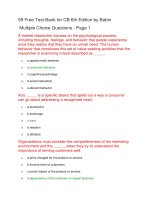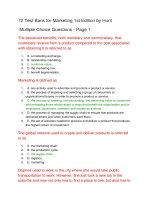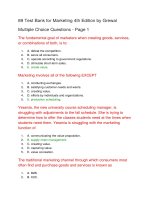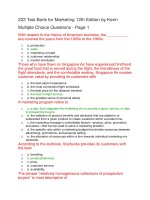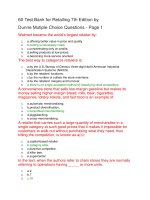Test bank for radiographic pathology for technologists 7th edition by kowalczyk
Bạn đang xem bản rút gọn của tài liệu. Xem và tải ngay bản đầy đủ của tài liệu tại đây (32.05 KB, 4 trang )
Chapter 01: Introduction to Pathology
Kowalczyk: Radiographic Pathology for Technologists, 7th Edition
MULTIPLE CHOICE
1. The sequence of events producing cellular changes following injury best defines
a. manifestations.
b. pathogenesis.
c. sign.
d. symptom.
ANS: B
2. An abnormal disturbance of the function and structure of the human body following injury refers to
a. disease.
b. etiology.
c. manifestations.
d. pathogenesis.
ANS: A
3. The study of the cause of disease is termed
a. disease.
b. etiology.
c. pathogenesis.
d. prognosis.
ANS: B
cause
disease
4. Common agents that
Test
Bank
forinclude
Radiographic
1. bacteria.
2. chemicals.
3. heat.
a. 1 and 2 only
b. 1 and 3 only
c. 2 and 3 only
d. 1, 2, and 3
Pathology for Technologists 7th Edition by Kowalczyk
Full file at />
ANS: D
5. A syndrome is best defined as
a. a genetic abnormality of a single protein.
b. an adverse response to medical treatment.
c. the patient’s perception of the disease.
d. signs and symptoms that characterizes a specific abnormal disturbance.
ANS: D
6. An adverse response to medical treatment itself is termed
a. autoimmune.
b. iatrogenic.
c. idiopathic.
d. nosocomial.
ANS: B
7. Prognosis refers to
a. diseases usually having a quick onset.
b. the name of the particular disease.
c. the predicted course and outcome of the disease.
d. the structure of cells or tissue.
ANS: C
8. Diseases that generally require a decrease in the exposure technique are considered
a. destructive.
b. lytic.
c. subtractive.
d. All of the above.
ANS: D
9. The investigation of disease occurring in large groups best defines
a. epidemiology.
b. incidence.
c. prevalence.
d. All of the above.
ANS: A
Copyright © 2018, Elsevier Inc. All Rights Reserved.
Full file at />
1
10. Data regarding the number of deaths caused by a particular disease averaged over a population are collected and reported by the
a. American College of Radiology.
b. Centers for Disease Control.
c. Food and Drug Administration.
d. National Center for Health Statistics.
ANS: D
11. Which of the following are leading causes of death in the United States for adults aged 45 years and greater?
1. Heart disease
2. Malignant neoplasm
3. Polycystic kidney disease
a. 1 and 2 only
b. 1 and 3 only
c. 2 and 3 only
d. 1, 2, and 3
ANS: A
12. In 2010 health spending accounted for approximately _____% of the US gross domestic product.
a. 12
b. 17
c. 21
d. 33
ANS: B
13. Each cell in the human body, except the reproductive cells, contains _____ pairs of autosomal chromosomes, _____ sex
chromosomes.
a. 11, 1
b. 11, 2
c. 22, 1
d. 22, 2
Test Bank for Radiographic Pathology for Technologists 7th Edition by Kowalczyk
Full file at />
ANS: D
14. The types of gene maps that grew out of the identification of DNA sequences include
1. genetic maps.
2. SNP maps.
3. physical maps.
a. 1 and 2 only
b. 1 and 3 only
c. 2 and 3 only
d. 1, 2, and 3
ANS: B
15. The identification of common DNA pattern sequences and common patterns of genetic variations of single DNA bases resulted in
a. the Genome Project.
b. genetic linkage maps.
c. haplotype mapping.
d. physical mapping.
ANS: C
16. Diseases that are present at birth from genetic or environmental factors are classified as
a. congenital.
b. degenerative.
c. genetic.
d. metabolic.
ANS: A
17. A genetic disorder caused by an abnormality on one of the 22 non-sex chromosomes is considered
a. autosomal.
b. dominant.
c. recessive.
d. sex linked.
ANS: A
18. A protein coat surrounding a genome of either RNA or DNA without an organized cellular structure best describes which type of
microorganism?
a. Bacteria
b. Fungi
c. Virus
d. All of the above
ANS: C
Copyright © 2018, Elsevier Inc. All Rights Reserved.
Full file at />
2
19. The ease with which a pathogenic organism can overcome the body’s defenses best describes
a. etiology.
b. infection.
c. pathogenesis.
d. virulence.
ANS: D
20. Diseases caused by the disturbance of normal physiologic function are classified as
a. degenerative.
b. metabolic.
c. neoplastic.
d. traumatic.
ANS: B
21. The lymph node into which the primary neoplasm drains during metastasis is termed the _____ node.
a. primary
b. sentinel
c. metastatic
d. neoplastic
ANS: B
22. The spread of cancerous cells into surrounding tissue by virtue of the close proximity best describes
a. lymphatic spread.
b. hematogenous spread.
c. invasion.
d. oncogenesis.
ANS: C
Test Bank for Radiographic Pathology for Technologists 7th Edition by Kowalczyk
23. Cancer originating in epithelial tissue is termed
Full file at />a. carcinoma.
b. leukemia.
c. lymphoma.
d. sarcoma.
ANS: A
24. In classification of a tumor using the TNM system, the T refers to the
a. size of the primary tumor.
b. lymph node involvement.
c. distant metastasis.
d. histologic grading of the primary tumor.
ANS: A
25. Which of the following imaging modalities are used in the staging of neoplastic tumors?
1. CT
2. PET
3. MRI
a. 1 and 2 only
b. 1 and 3 only
c. 2 and 3 only
d. 1, 2, and 3
ANS: D
26. In the treatment of neoplastic disease, interferons and interleukins are associated with
a. chemotherapy.
b. radiation therapy.
c. hormone therapy.
d. immunotherapy.
ANS: D
MATCHING
Altered cell biology
Directions: Match the type of altered cell biology with the correct description.
Description of altered cell biology
a. A generalized decrease in cell size
b. A generalized increase in cell size
c. An increase in the number of cells in tissue as a result of excessive proliferation
d. Conversion of one cell type into another cell type
e. Abnormal changes of mature cells
1.
2.
3.
4.
Hypertrophy
Atrophy
Metaplasia
Hyperplasia
Copyright © 2018, Elsevier Inc. All Rights Reserved.
Full file at />
3
5. Dysplasia
1.
2.
3.
4.
5.
ANS:
ANS:
ANS:
ANS:
ANS:
B
A
D
C
E
TRUE/FALSE
1. A tumor consisting of differentiated cells has a higher probability for malignancy.
ANS: F
2. A histologic evaluation of a primary cancer that is graded as an “I” is considered well differentiated.
ANS: T
Test Bank for Radiographic Pathology for Technologists 7th Edition by Kowalczyk
Full file at />
Copyright © 2018, Elsevier Inc. All Rights Reserved.
Full file at />
4
